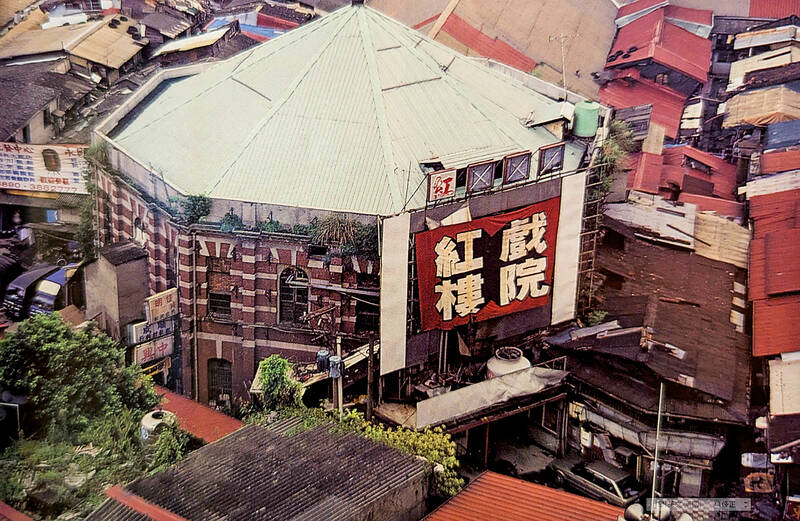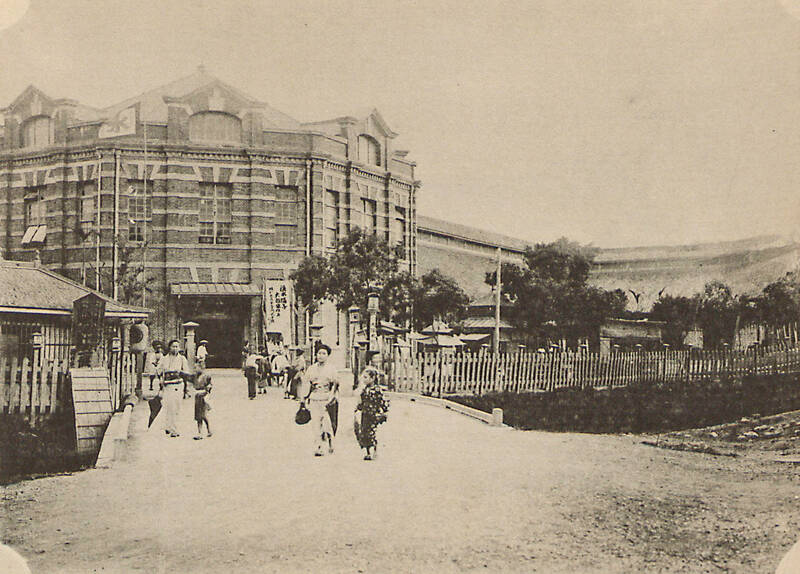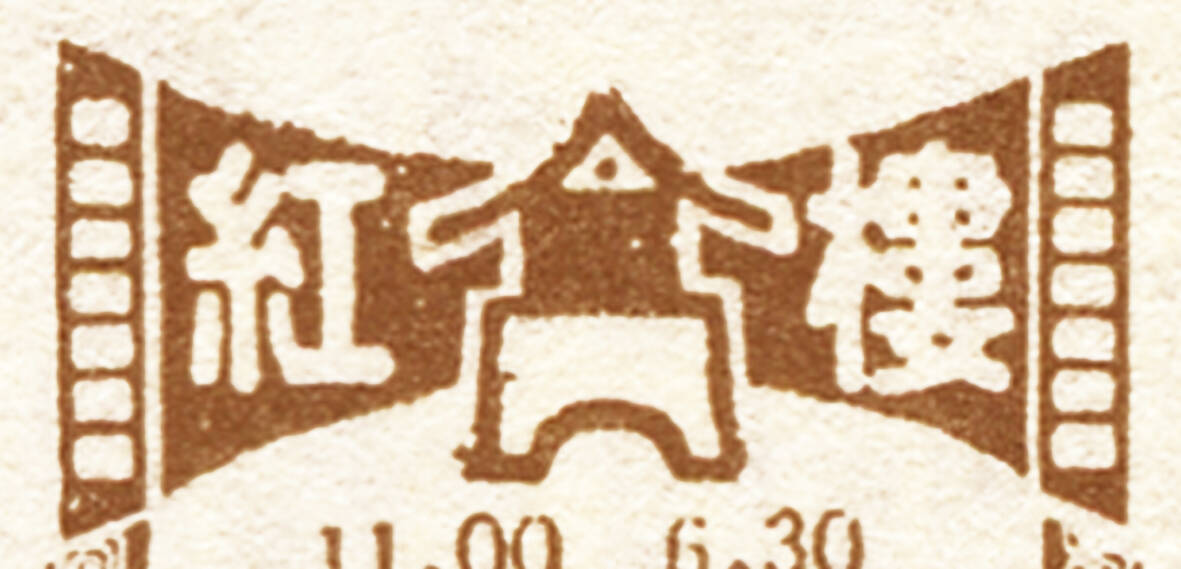Dec. 16 to Dec. 22
Growing up in the 1930s, Huang Lin Yu-feng (黃林玉鳳) often used the “fragrance machine” at Ximen Market (西門市場) so that she could go shopping while smelling nice. The contraption, about the size of a photo booth, sprayed perfume for a coin or two and was one of the trendy bazaar’s cutting-edge features.
Known today as the Red House (西門紅樓), the market also boasted the coldest fridges, and offered delivery service late into the night during peak summer hours. The most fashionable goods from Japan, Europe and the US were found here, and it buzzed with activity from morning to evening as the city’s prime entertainment center.

Photo courtesy of Wikimedia Commons
The unique building in the shape of an octagon and cross was inaugurated on Dec. 20, 1908 as one of the first shopping centers catering to the Japanese residents living near today’s Ximending area.
Unlike Taiwanese markets, Ximen had a manager who oversaw operations and kept strict tabs on the environment, making sure it was clean, well-ventilated and pleasant to walk through. Prices were fixed and clearly marked. There were 23 shops in the octagonal-shaped building on opening day selling ceramics, hardware, liquor, toys, tea, Western goods, coffee, medical equipment, sweets and calligraphy supplies. The cross-shaped part had numerous stalls offering vegetables, meat, fish and other foodstuffs.
Huang was especially fond of visiting the building’s used book stands, she recalled in The Red House 100 Years (西門紅樓百年故事書) by Chiu Li-hui (邱莉慧). She was working at a Japanese-owned fabric store in the market when US airstrikes hit Taipei on May 31, 1945. The market was unscathed but the Shinto shrine was damaged beyond repair. Many of Huang’s friends died or were seriously injured.

Photo courtesy of Wikimedia Commons
Carefully maintained throughout Japanese rule, the fate of the market changed rapidly after World War II, finally becoming a historical site in 1997. Today it remains a vibrant public space.
MOST FASHIONABLE SPOT
When the Japanese took over Taiwan in 1895, they set up their headquarters in the walled city of Taipei. The newly-arrived Japanese immigrants living near the West Gate (Ximen in Chinese) could not get used to the Taiwanese markets, plus there was a language barrier. In 1896, the government built Shinkicho Market (新起街市場) in front of Wanhua’s Qingshui Temple (清水巖) to the west of the city.

Photo courtesy of National Central Library
The Japanese demolished the West Gate and city walls in 1904 to expand the city, and planned to move Shinkicho Market closer to the Ximen area. This new market was to be built on 3,041 hectares of land mostly containing unmarked graves; records show that 71 households were compensated for their losses, Chiu writes. The colonial government gave people until March 20, 1908 to claim and relocate the graves, but more than 1,000 unclaimed ones were moved to a public cemetery. Roads were built to encircle the grounds, making up today’s Xining South Road (西寧南路), Chengdu Road (成都路), Hanzhong Road (漢中路) and Neijiang Street (內江街).
On opening day, a city official remarked that in the past, there was no one-stop-shop for people’s everyday needs; they had to buy vegetables from hawkers in the street, meat from Dadaocheng and dried goods from within the formerly walled city.
Ximen Market quickly established itself as the most fashionable shopping space in Taiwan throughout the Japanese colonial era. In addition to the latest items and novelties, it also served as an entertainment center that remained lively late into the night with outdoor performances and other activities. It was a popular spot to shop before the Lunar New Year, remaining open until midnight in the 10 days before the holiday. There were also occasions when it would stay open all night.

Photo courtesy of Taiwan Film and Audiovisual Institute
PERFORMANCE SPACE
In 1928, an additional row of Art Deco buildings were erected next to the main structure, offering high-end products such as Japanese paper, weaving and other high-end specialities.
In 1930, a cafe opened in the second floor of the octagon building, transforming a decade later into an amusement center featuring pool tables, airguns, game machines and rides for children.
Towards the end of the Chinese Civil War in 1949, Shanghai merchant Chen Hui-wen (陳惠文) rented the space and started the Huyuan Theater troupe (滬園劇場), mostly featuring singers who performed Beijing Opera and pop tunes. This failed to attract crowds, so in May he renamed the space Huyuan Tea Shop and turned to comedy, which included traditional xiangsheng (相聲), or crosstalk, and slapstick acts.
However, Huyuan was shut down in October for “playing obscene songs,” and that December it rebranded itself as Dazhong Theater (大眾劇場), which offered Shaoxing Opera, a variety of performance that became a hit with many refugees from China. Mandarin plays were also performed in accordance with the Chinese Nationalist Party (KMT) language policy.
During this time, a mezzanine was added as living quarters for the performers. The first floor’s shops went from chic items to catering to the troupe’s daily needs, selling rice, coal, costumes and buttons.
HAUNTED HOUSE?
Yang Jung-hua (楊榮華), who arrived in Yang Jung-hua (楊榮華), who arrived in Taiwan from Shanghai in 1945, spent nearly 50 years at Ximen Market, starting out playing mostly comedic relief characters for performance troupes. Although they often attracted sold-out crowds, Yang recalled that the building had deteriorated in the 1950s and people had to watch the show under umbrellas when it rain.
Meanwhile, during a renovation the actors were shocked to discover human bones. Apparently, the Japanese hadn’t removed all of the graves. The workers eventually put the remains in buckets and buried them under the nearby Zhongxing Bridge (中興橋).
The discovery led to rumors that the place was haunted, which is why some say that the architects intentionally designed the buildings using the two main features — the octagon to represent the eight trigrams and the cross to represent Christianity, thus drawing on Eastern and Western spiritual forces to suppress malevolent ghosts.
In 1963, as the popularity of traditional theater waned, the Red House became a movie theater, with Yang as manager. It showed second-round Western films and local productions, and was popular among students who could watch as many movies as they wanted with the purchase of one ticket. However, with the opening of new, more advanced theaters nearby, business dropped off.
Yang said they turned to pornographic films to survive. Long before the first gay bar opened in the area surrounding the Red House in 2006, the theater became a popular gathering spot for homosexuals, who made use of the seldom-visited, dark theaters showing illicit films. At one point, they made up the majority of Yang’s customers.
During the 50s and 60s, two new sections of makeshift stalls and shops popped up around the main building, totaling 262 at one point, creating significant chaos. Chiu writes that the vendors tried to improve the market’s condition over the following decades, even mulling a plan to raze the Red House for a 50-story high rise with a helipad, but a consensus was never reached.
As Taipei’s business district shifted eastward in the 1990s, the market fell into disuse with only a handful of shops remaining. In 1994, cultural activists put on a series of performances and activities to bring public attention to this forgotten structure, buried among all sorts of illegal stalls and a mishmash storefronts.
The new sections, along with the cross structure, burned down in 2000. Only then did the surviving octagonal building emerge as the structure that we see today.
Taiwan in Time, a column about Taiwan’s history that is published every Sunday, spotlights important or interesting events around the nation that either have anniversaries this week or are tied to current events.

April 14 to April 20 In March 1947, Sising Katadrepan urged the government to drop the “high mountain people” (高山族) designation for Indigenous Taiwanese and refer to them as “Taiwan people” (台灣族). He considered the term derogatory, arguing that it made them sound like animals. The Taiwan Provincial Government agreed to stop using the term, stating that Indigenous Taiwanese suffered all sorts of discrimination and oppression under the Japanese and were forced to live in the mountains as outsiders to society. Now, under the new regime, they would be seen as equals, thus they should be henceforth

Last week, the the National Immigration Agency (NIA) told the legislature that more than 10,000 naturalized Taiwanese citizens from the People’s Republic of China (PRC) risked having their citizenship revoked if they failed to provide proof that they had renounced their Chinese household registration within the next three months. Renunciation is required under the Act Governing Relations Between the People of the Taiwan Area and the Mainland Area (臺灣地區與大陸地區人民關係條例), as amended in 2004, though it was only a legal requirement after 2000. Prior to that, it had been only an administrative requirement since the Nationality Act (國籍法) was established in

Three big changes have transformed the landscape of Taiwan’s local patronage factions: Increasing Democratic Progressive Party (DPP) involvement, rising new factions and the Chinese Nationalist Party’s (KMT) significantly weakened control. GREEN FACTIONS It is said that “south of the Zhuoshui River (濁水溪), there is no blue-green divide,” meaning that from Yunlin County south there is no difference between KMT and DPP politicians. This is not always true, but there is more than a grain of truth to it. Traditionally, DPP factions are viewed as national entities, with their primary function to secure plum positions in the party and government. This is not unusual

US President Donald Trump’s bid to take back control of the Panama Canal has put his counterpart Jose Raul Mulino in a difficult position and revived fears in the Central American country that US military bases will return. After Trump vowed to reclaim the interoceanic waterway from Chinese influence, US Defense Secretary Pete Hegseth signed an agreement with the Mulino administration last week for the US to deploy troops in areas adjacent to the canal. For more than two decades, after handing over control of the strategically vital waterway to Panama in 1999 and dismantling the bases that protected it, Washington has